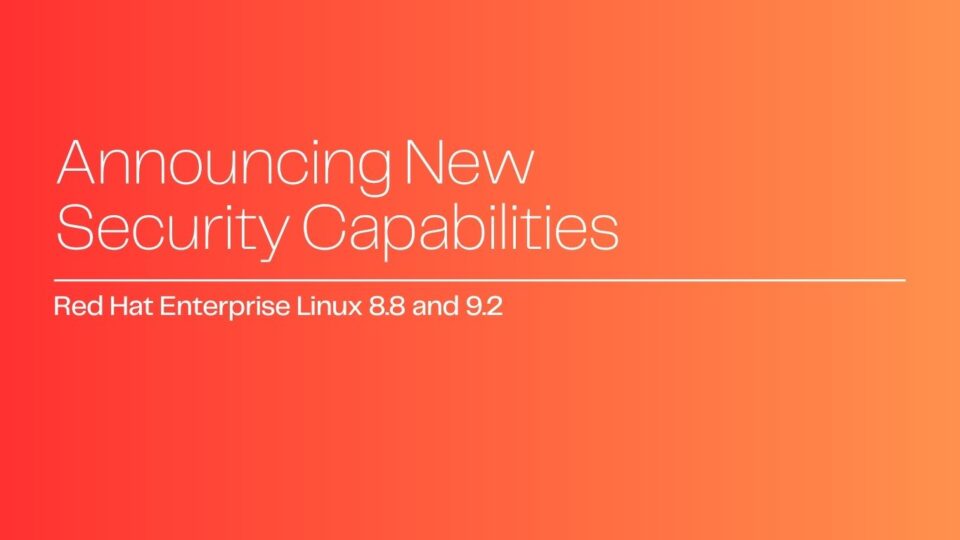Are enterprise hardening their stance against security attacks and data breaches? Not quiet, state all the latest reports that cover and analyze different kinds of IT events and incidents! One such report found 83 percent of the global organizations are vulnerable to a data breach. Worse, could be two! The average cost of a data breach hovers between $9M and $10M in the US. For non-US firms, this price of data breach is almost half. So, is there a way to predict security incidents before they happen, and two, can these attacks be prevented with brute force? To answer both questions, we decided to explore the latest security capabilities introduced by Red Hat as part of its new additions within RHEL.
Read More: Transform Your Business: Why AI Adoption is the Key to Your Business…
To meet ever-rising global security demands, IBM’s Red Hat has added new capabilities to its existing Red Hat Enterprise Linux (RHEL) 8.8 and 9.2 Beta. These security features would empower IT teams to detect, analyze and respond to any kind of crisis at a faster rate, saving millions of dollars from getting wiped out despite having “somewhat” security and compliance in order within the organization.
CIOs expect their IT assets to be fully-protected from day-one.
According to a recent report, 77% of the respondents (largely CEOs and IT leaders) found it extremely challenging when it comes to aligning overall enterprise security tools with their current security goals. To remove vulnerabilities, DevOps teams have to be extra cautious. In fact, this “cautious” approach is keeping DevOps teams busy! According to Dynatrace, DevOps teams spend nearly a third (31%) of their time on manual tasks involving detecting code quality issues and vulnerabilities, reducing the time spent on innovation.
The skewed expectations from the security infrastructure put intense pressure on the current IT security resources which leaders expect to deliver from the moment these tools are deployed within the organization.
What are these new capabilities that Red Hat has added to RHEL 8.8 and 9.2 Beta?
Red Hat Enterprise Linux (RHEL) 8.8 and 9.2 Beta is designed to deliver maximum flexibility and agility to open source Hybrid Cloud foundations. Hybrid Cloud inherently faces more security and compliance issues compared to other types of cloud platforms. These security issues are mostly related to real-time risks assessment, data redundancy, data privacy, DDoS attacks, and data governance. RHEL 8.8 and 9.2 Beta would address these challenges with a greater ability to deliver workloads, applications and services spread across multiple environment.
Here is what Red Hat added to its RHEL system.
Secured DevOps that is Compatible with New Python and PCP versions
Python DevOps teams commonly face injection vulnerabilities in their coding workflows. This security issue lets in the attacker into the coding system and allows them to execute a code targeting the development environment. Red Hat Enterprise Linux (RHEL) 8.8 and 9.2 addresses this security flaws in the Python development environment. Now, application development team can secure their resources and coding platforms on Python 3.11 as well as Nginx 1.22 which is now OpenSSL 3.0 compatible.
Beside this, RHEL 8.8 and 9.2 would also link to PostgreSQL 15 with new security features and a significant performance speed-up.
Enhanced capabilities within RHEL beta also include addition of a realmd RHEL system role. This role would allow Red Hat users to automatically integrate the RHEL systems with Microsoft Active Directory. Moreover, users can also align their security check-ins with the Center for Internet Security (CIS) benchmarks for RHEL 9 (RHEL 9.2 Beta only).
Mitigating Risks in Edge Environment
Edge computing is coming out of its nascent stage. Many enterprise-level edge strategies are focusing on building a light-weight infrastructure to deploy and scale their IT assets in real-time with faster agility, stronger security and superior flexibility. RHEL is targeting edge users that are deploying workloads in distributed computing systems, promising better remote management and monitoring. The new security capabilities address edge requirements by adding a zero-touch provisioning method for edge systems as an alternative to FIDO Device Onboard (FDO).
Read Also: The Riskiest Connected Healthcare Devices Continuing to Pose a Threat in 2023
Red Hat users can enhance their security posture in a more consistent manner by adopting new security configurations that can do these:
- Import and export blueprint files
- Append kernel boot parameters
- Enable or disable services
- Enable or disable firewall rules for ports and services
- Define users and groups
- Define SSH public keys for remote access
- Define time zone and time servers
- Define language and locale
- Define installation device
- Define URL to ignition files for an additional zero-touch provisioning method for edge systems
Read Also: VirnetX Partners with WeSecure
Conclusion
In the upcoming IBM Red Hat Summit 2023, we are expecting to see the RHEL 8.8 and 9.2 (beta only) in full action. We are particularly keen about the session titled, “Container security lab with Red Hat Enterprise Linux 9”. This session would focus on the growing role of Linux containers and how these have become ubiquitous for application packaging in open source hybrid environments. By attending Red Hat’s Summit 2023, you would be gaining abundant experience in handling security frameworks in open hybrid cloud infrastructure, security, DevOps, AI/ML, culture and more.
Read More: The Riskiest Connected Healthcare Devices Continuing to Pose a Threat in 2023


